Hobby Boss 1/32 IL-2M 'Shturmovik'
|
KIT #: |
23203 |
|
PRICE: |
11,840 yen (about $146.00) from
www.hlj.com
|
|
DECALS: |
Two options |
|
REVIEWER: |
Tom Cleaver |
|
NOTES: |
Alternative main gear in metal |
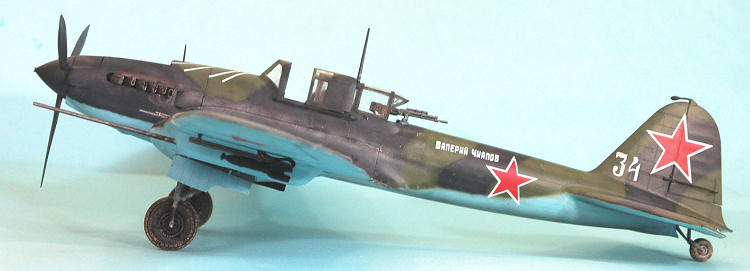
To the people of the Soviet Union during the Great
Patriotic War, the Ilyushin Il-2 “Shturmovik” was everything the Spitfire was to
the British and the Zero to the Japanese: the symbol of a nation’s fighting
spirit.
To the crews, it was simply “Ilyusha;” to the troops on the ground, it
was the "Hunchback," the "Flying Tank" or the "Flying Infantryman."
Josef Stalin once said "They are as essential to the Red
Army as air and bread." 36,163 Il-2s were produced between 1941 and 1945, making
it certainly the most-produced attack aircraft in history.
In early 1939, Sergei Ilyushin set out independently to
design a Bronirovaniy Shturmovik, an
armored assault aircraft.
The two seat prototype, designated TsKB-55, first flew
on October 2, 1939.
It was quickly determined by those in authority that the
airplane needed only a pilot, and it was suitably modified as the TsKB-57, which
first flew on October 17, 1940. The airplane was constructed around an armored
“bath” which enclosed the engine and cockpit.
Powered buy the reliable Mikulin AM-38F liquid-cooled
V-12, the Il-2 as it was now known carried one 7.62mm machine gun and one 20mm
cannon in each wing, and could carry small bombs in internal bomb bays inboard
of the landing gear, as well as RS-82 rockets and larger bombs that would be
carried externally over the wing bomb bays.
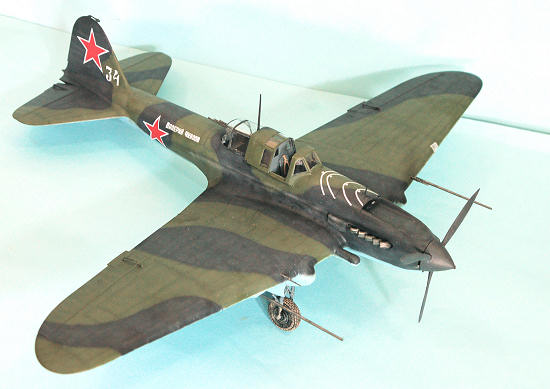 Production deliveries to the V-VS began in May 1941.
When the Nazis launched Case Barbarossa,
the invasion of the
Soviet Union,
on
June 22, 1941
there were only 249 Il-2s operational in the V-VS.
These were thrown into battle and were slaughtered by
the Luftwaffe, since they had no rear
defense, the pilots did not know enough about the
airplane to put them to best use, and no real strategy and set of tactics had
been developed for ground assault.
A pilot who survived 10 missions was declared a Hero of
the
Soviet Union.
By early 1942, the front line units were modifying their
Il-2s with a second open seat behind the pilot outside of the armor bath, armed
with whatever weapon was available.
By September 1942, the factories began producing the
IL-2M (Modifikatsirovannii, or
Modified), which had a simple rear seat with a side hinging canopy and a 12.7
Beresin UBT machine gun with 500 rounds.
The gunner’s seat was simply a leather strap hung in the
space.
This did a lot for defense, but losses were still high due to the lack
of experience of pilots thrown into Shturmovik units with less than 100 hours
total flight training time.
Production deliveries to the V-VS began in May 1941.
When the Nazis launched Case Barbarossa,
the invasion of the
Soviet Union,
on
June 22, 1941
there were only 249 Il-2s operational in the V-VS.
These were thrown into battle and were slaughtered by
the Luftwaffe, since they had no rear
defense, the pilots did not know enough about the
airplane to put them to best use, and no real strategy and set of tactics had
been developed for ground assault.
A pilot who survived 10 missions was declared a Hero of
the
Soviet Union.
By early 1942, the front line units were modifying their
Il-2s with a second open seat behind the pilot outside of the armor bath, armed
with whatever weapon was available.
By September 1942, the factories began producing the
IL-2M (Modifikatsirovannii, or
Modified), which had a simple rear seat with a side hinging canopy and a 12.7
Beresin UBT machine gun with 500 rounds.
The gunner’s seat was simply a leather strap hung in the
space.
This did a lot for defense, but losses were still high due to the lack
of experience of pilots thrown into Shturmovik units with less than 100 hours
total flight training time.
The heavy armor protection meant an Il‑2 could take a
lot
of punishment. One Il‑2 returned safely despite having been the target
of more than 600 direct hits from 20mm and 37mm flak, which shredded all its
control surfaces completely, as well as other structural damage.
However, the Shturmovik suffered heavy losses.
The Luftwaffe claimed 6,900 Il‑2s in 1943 and 7,300 in
1944; while it is known these figures were exaggerated, the actual losses were
substantial.
About half of a Shturmoviks lost were shot down by fighters, the
rest falling to flak.
The heavy armor meant that the warload of the Shturmovik
was relatively light.
The RS-82 rockets were so inaccurate and impossible to
aim that any hit was the result of chance. While attacks against targets such as
horse and truck convoys and rail yards had could and did have devastating
results, attacks against dug‑in point targets were frequently ineffective.
With comparatively light bomb‑loads and the poor
accuracy of its attacks, the individual Shturmovik was far less effective an
attack aircraft than Allied fighter‑bombers like the P‑47 Thunderbolt and Hawker
Typhoon.
The Shturmovik and its crews began to perform as
anticipated during the Soviet offensive launched against the Wehrmacht on
December 6, 1941
on the outskirts of
Moscow,
where it gained a reputation as a tank killer.
This was enhanced in 1942 in the Il-2M when many of
these aircraft were produced with two 37mm anti-tank cannon in underwing
housings.
The weight of these weapons made a sluggish airplane even more
so, but the hitting power of the anti-tank Shturmoviks attacking German panzers
from the rear was so impressive the Luftwaffe copied this the following year
with the cannon-armed Ju-87G
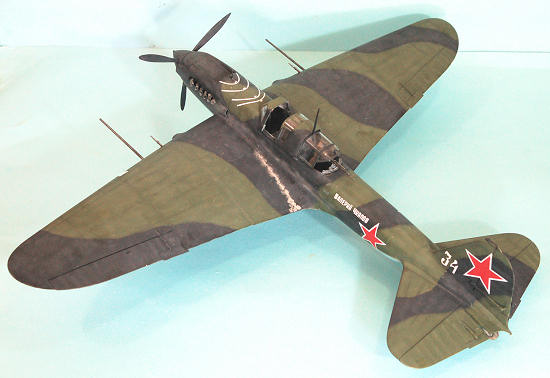 Stuka.
Of course, there were 500 anti-tank Shturmoviks to every
Panzershreck Stuka, which still gave
the Soviets overwhelming superiority.
The anti-tank Il-2M was crucial to the Soviet victory at
Stalingrad,
fought between October 1942 and February 1943, as well as at the
Battle
of Kursk-Orel fought in July and August 1943.
Losses of Shturmoviks in both battles were horrendous,
but after
Kursk
the backbone of the German panzer forces had been decisively broken.
Stuka.
Of course, there were 500 anti-tank Shturmoviks to every
Panzershreck Stuka, which still gave
the Soviets overwhelming superiority.
The anti-tank Il-2M was crucial to the Soviet victory at
Stalingrad,
fought between October 1942 and February 1943, as well as at the
Battle
of Kursk-Orel fought in July and August 1943.
Losses of Shturmoviks in both battles were horrendous,
but after
Kursk
the backbone of the German panzer forces had been decisively broken.
The Il-2M had been a straight modification of the
single-seater.
It was found that the addition of a gunner, his weapon and ammo
adversely affected the center of gravity and made the airplane even more
difficult to fly than originally.
In the spring of 1943, the Il-2M3 (third development)
went into production.
This had wooden outer wings that were swept back 15
degrees to deal with the CG problem. In late 1944, as aluminum supplies became
more available, the final version of the IL-2M3 appeared with metal outer wings.
The overwhelming number of Shturmovik crews had short,
bloody, anonymous combat careers, with the average life of a Shturmovik being
approximately 20-22 missions.
However, there were some whose achievements in this
airplane were extraordinary.
One of the more interesting pilots to go to war in the
Shturmovik was Lieutenant Anna Egorova, who had previously flown Po-2 biplanes
on night harassment missions.
At age 26 in 1942, she became the first woman pilot to
join a Shturmovik regiment.
As she recalled in her 2005 memoir
Over Fields of Fire: “...not everyone met me with sympathy
in the ground attack regiment.
There were some who grumbled under their breath: ‘What
good is a woman in ground attack aviation?’
But the regiment navigator, Peter Karev, shushed them:
‘The regiment’s not getting a woman, it’s getting a combat pilot.’”
Given two days to learn the Shturmovik before going out
to the 805th Ground Attack Aviation
Division, she flew anti-tank missions through the Battles of Stalingrad and
Kursk, and eventually rose to command an Escadrilyi
(squadron) by the spring of 1944.
Shot down over Poland after 230 combat missions during
which she went through more than ten airplanes, Anna was severely injured and
taken prisoner.
Liberated from German captivity five months later by Soviet
troops, she was treated as a traitor, as were all former POWs.
She was luckier than many who were sent to their deaths
in the Siberian gulags if not shot out of hand, and was eventually able to clear
her name. Anna Egorova was finally given the award of Hero of the Soviet Union
in 1965.
 One of the most unusual stories about the Shturmovik is
that of Sergeant pilot T. Kuznetsov.
Returning from a recon mission in 1942, his Il-2 was
brought down by German flak.
He survived the crash landing and found a nearby hiding
place, then watched, amazed, as a Bf-109F landed in the open field.
The German pilot shut down, climbed out, and went over
to the crashed Shturmovik in search of souvenirs.
Kuznetsov sprinted to the Bf-109 and climbed in.
He managed to start it up and take off.
Barely avoiding being shot down by Soviet fighters, he
was made a Hero of the Soviet Union on the spot when he landed back at base.
One of the most unusual stories about the Shturmovik is
that of Sergeant pilot T. Kuznetsov.
Returning from a recon mission in 1942, his Il-2 was
brought down by German flak.
He survived the crash landing and found a nearby hiding
place, then watched, amazed, as a Bf-109F landed in the open field.
The German pilot shut down, climbed out, and went over
to the crashed Shturmovik in search of souvenirs.
Kuznetsov sprinted to the Bf-109 and climbed in.
He managed to start it up and take off.
Barely avoiding being shot down by Soviet fighters, he
was made a Hero of the Soviet Union on the spot when he landed back at base.
Georgi Beregovoy, who later became a cosmonaut and flew
Soyuz-3 on October 25. 1968, joined the
V-VS in 1941 and survived 185 missions in the Shturmovik, ending the war as a
Captain and squadron commander.
The Shturmovik units had the highest combat loss rates
in the V-VS.
Of 36,000 built during the war, there were fewer than 8,000 on
operations as of V-E Day in May, 1945.
Hobby Boss began releasing the Il-2 series with the
least-popular version, the single-seater on skis, this past year.
This
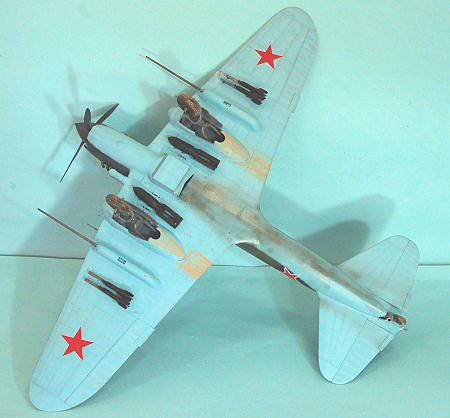 was
followed at the beginning of 2011 with the wheeled single-seater; this release
of the first two-seater will be followed this fall by the definitive Il-2M3.
was
followed at the beginning of 2011 with the wheeled single-seater; this release
of the first two-seater will be followed this fall by the definitive Il-2M3.
The kit features petite engraved panel and rivet detail,
with good representation of fabric control surfaces.
The pilot’s cockpit is well detailed.
There is a fully-detailed AM-38F engine, which can be
displayed by leaving the clear plastic engine cowling unpainted.
There are separate control surfaces and optional
position flaps, wing armament with magazines (which the modeler must open up on
his or her own to display the interior detail).
The underwing cannon pods are molded in clear plastic to
display the fully-detailed cannons.
The wing bomb bays can be assembled with doors open or
closed.
The ammunition belts and main tires are vinyl.
A set of white metal main gear struts are provided to
replace the plastic parts.
Photo‑etch parts are provided for the seatbelts and bomb
bay details.
The kit also includes an extensive ordnance choice, with
everything ever carried by a Shturmovik:
general purpose
FAB‑50,
FAB‑100,
DAB‑100,
BRAB‑220 and
FAB‑250
bombs),4 ROFS‑132 rockets and 8 RS‑82 rockets.
Decals are provided for two aircraft, “White 24" and
“Yellow 31.” For a look at what comes in the box, please
visit the
preview.
Construction is straightforward, with good instructions
and parts that fit.
I started by pre-painting the cockpit parts and then
assembling the forward cockpit.
There is very little to the rear cockpit.
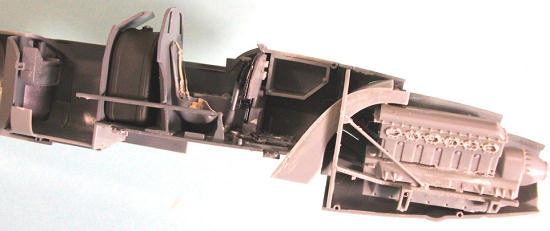 Since I
wasn’t planning on displaying the engine, I only assembled the block and the
cylinder heads, and attached that to the bearer arms.
This was all then assembled in the fuselage, and the
fuselage was glued together.
Since I
wasn’t planning on displaying the engine, I only assembled the block and the
cylinder heads, and attached that to the bearer arms.
This was all then assembled in the fuselage, and the
fuselage was glued together.
I decided I would build the model with the bomb bays
closed, so I used some Evergreen strip inside the center lower wing to reinforce
the bomb bay doors as I glued them in position.
I then assembled the center wing section and attached
that to the fuselage.
I assembled the outer wings and attached them, using the
wing spars to insure a solid fit.
This was finished off by assembling and attaching the horizontal tail
surfaces and the rudder.
When I went to attach the cowling parts, I discovered I
had to remove the exhausts from the cylinder heads to accomplish this.
I set them aside in the detail parts box for later
assembly after painting.
I used Tamiya “NATO Green” and Tamiya “NATO Black” for
the upper camouflage, and mixed Tamiya “Flat Blue” and Flat white” to get the
lower surface color.
All the camouflage was freehanded after I pre-shaded the
panel lines.
I post-shaded each color by adding in white to go back over the
surfaces.
I finished off with a coat of Xtracrylix Gloss.
The kit decals provided no problems. The
slogan on the fuselage is a dedication to "Valery Chkalov", famous Soviet test
pilot.
I wanted to do an otherwise-anonymous Shturmovik, as the
vast majority of them were.
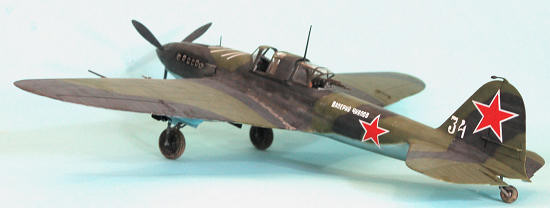 I unmasked the canopy.
I attached the Beresin machine gun, and then glued the
gunner’s canopy closed.
The pilot’s canopy was slid all the way back to show
detail.
The landing gear was attached, followed by the underwing armament.
In researching the airplane, I didn’t find any photos of
heavily-weathered Shturmoviks, which makes sense since most of them didn’t last
long enough to get all dinged.
I did some “scraping” where the crew would have boarded,
and included exhaust and oil stains.
I “muddied” the wheels, landing gear, underside of the
wings behind the wheels, and the wheel wells.
I unmasked the canopy.
I attached the Beresin machine gun, and then glued the
gunner’s canopy closed.
The pilot’s canopy was slid all the way back to show
detail.
The landing gear was attached, followed by the underwing armament.
In researching the airplane, I didn’t find any photos of
heavily-weathered Shturmoviks, which makes sense since most of them didn’t last
long enough to get all dinged.
I did some “scraping” where the crew would have boarded,
and included exhaust and oil stains.
I “muddied” the wheels, landing gear, underside of the
wings behind the wheels, and the wheel wells.
An easy model of an historically-important airplane.
I find it interesting that both the Shturmovik and the
Stuka are about the same size, and that both are not as big as an SBD, which
looks enormous sitting next to them on the dive bombers shelf.
Highly recommended to fans of Soviet aviation in the
Great Patriotic War.
Tom
Cleaver
July 2011
Review kit courtesy
of HobbyLink Japan.
Order yours at:
http://www.hlj.com/product/HOB23203
If you would like your product reviewed fairly and fairly quickly , please
contact
me or see other details in the
Note to
Contributors.
Back to the Main Page
Back to the Review
Index Page



 Stuka.
Of course, there were 500 anti-tank Shturmoviks to every
Panzershreck Stuka, which still gave
the Soviets overwhelming superiority.
The anti-tank Il-2M was crucial to the Soviet victory at
Stuka.
Of course, there were 500 anti-tank Shturmoviks to every
Panzershreck Stuka, which still gave
the Soviets overwhelming superiority.
The anti-tank Il-2M was crucial to the Soviet victory at

 was
followed at the beginning of 2011 with the wheeled single-seater; this release
of the first two-seater will be followed this fall by the definitive Il-2M3.
was
followed at the beginning of 2011 with the wheeled single-seater; this release
of the first two-seater will be followed this fall by the definitive Il-2M3. Since I
wasn’t planning on displaying the engine, I only assembled the block and the
cylinder heads, and attached that to the bearer arms.
This was all then assembled in the fuselage, and the
fuselage was glued together.
Since I
wasn’t planning on displaying the engine, I only assembled the block and the
cylinder heads, and attached that to the bearer arms.
This was all then assembled in the fuselage, and the
fuselage was glued together.